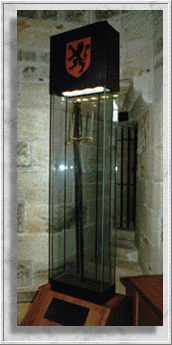History of BraveheartCharactersWilliam Wallace BattlesMovie Info Oscar Page |
William WallaceWilliam Wallace was one of the greatest patriots in the history of Scotland and as little is known of his life, except for the short period which saw his rebellion, victory, defeat and execution, his legend has an untouchable quality about it that in spirit at least captures the true atmosphere of his struggle. He was, it seems, the second son of a petty landowner whose fields lay not far distant from the present town of Paisley, almost in the middle of Scotland's lowland belt. He was described by one chronicler as a 'former chief of brigands' but as we bitterly know from our own times the terrorists and criminals of yesterday are often such only in the nomenclature of their enemies. He may have been of Strathclyde British stock and if this is so he carried a more ancient residential lineage than the Scots whose eponymous land he fought and died for.We know for sure that in 1297 he killed the Sheriff of Lanark. Legend says this was in revenge for the slaying of his wife. Whether it was so is of little consequence except to romantics, for in committing such an act Wallace pushed himself and his followers into open rebellion. It was a rebellion already in progress and was not started by Wallace. He led several successful raids of English garrisons and led the Scots to victory against the English at the Battle of Stirling Bridge. For this victory he was dubbed Sir William Wallace High Guardian of Scotland by Robert the Bruce. He was later outnumbered and defeated at Falkirk and narrowly escaped his life.
|
 Most of what is known about William Wallace is myth and legend. Some of these myths are
portrayed as fact in Braveheart, some are portrayed as myths, such as Wallace's rumored height.
Actually this is believed to be a fact, Wallace's claymore on display at the William Wallace Memorial
Monument at Stirling Castle is five and a half feet long. It is highly unlikely that a man of average height
could have wielded such a weapon in battle.
Most of what is known about William Wallace is myth and legend. Some of these myths are
portrayed as fact in Braveheart, some are portrayed as myths, such as Wallace's rumored height.
Actually this is believed to be a fact, Wallace's claymore on display at the William Wallace Memorial
Monument at Stirling Castle is five and a half feet long. It is highly unlikely that a man of average height
could have wielded such a weapon in battle.
 As silly as this may seem some scholars believe
that the legendary English outlaw wasn't English after all but William Wallace. The similarities, I must admit
are uncanny.
As silly as this may seem some scholars believe
that the legendary English outlaw wasn't English after all but William Wallace. The similarities, I must admit
are uncanny.
Whether or not Wallace really was the basis for the Robin Hood legend nobody will ever know for sure. A good deal of the similarities could be said about many outlaws of the middle ages. This much like the film itself relies on what one wants to believe.